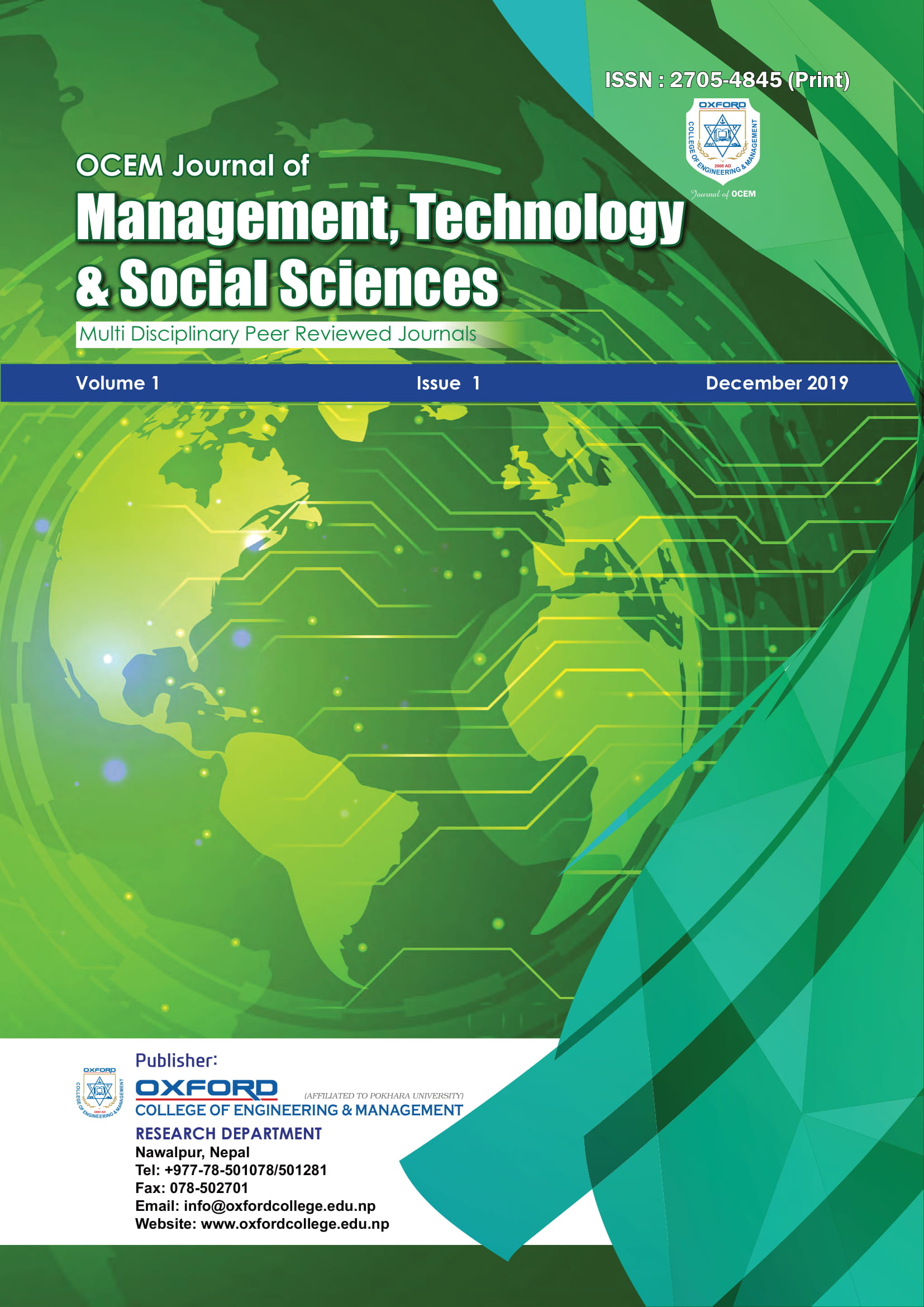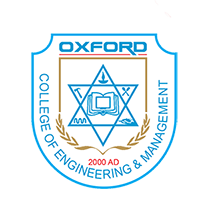Factors Influencing Students’ Satisfaction in Oxford College of Engineering and Management, Gaindakot-2, Nawalpur of Nepal
Abstract
The objective of this study was to examine the students’ recommendation to their kith and kin to enrol at Oxford College of Engineering and Management (OCEM) for the higher education study. The previous
studies reveal that students’ satisfaction was embedded in collage physical facilities, administrative facilities, program quality, quality of academic staff, location of college and reputation of colleges. Quantitative research approach was used as research methodology and the survey study was use as research method applied to collect data from the respondents. The sampling methods was first purpsive and the second was random sampling method. Two hundred and thirty seven respondents (n=237) were participated in this study. The response rate of the survey questionnaire was 94.8 %. The reliability analysis was used to find the value of Cronbach’s Alpha in order to find out the reliability and consistency of the data. Twelve subscales were extracted from the variables of each Principal Component. Similarly, Student t-Test was used to find the differences in boys and girls for their recommendation to enrol their kith and kin at OCEM, Nawalpur of Nepal. Fifty seven male (24 %) and one hundred and eighty female (76 %) students were participated in this study. The results highlighted that female students were more satisfied than the male students at OCEM.
The results aslo show that strict student development schedule was positively and statistically significantly
associated with the preference of students’ recommendation to enrol their kith and kin at OCEM (p < 0.05, B = .486). Similarly, the results further show that physical facilities of OCEM was positively and statistically significantly associated to students’ preference to recommend their kith and kin to enrol at OCEM (p < 0.05. B = 1.038). The results of Multiple Regression Analysis also highlighted that there
is significance association between students’ preference and locations of the college. The implications of the findings will be beneficial for the private and public colleges to understand the reason behind the declining trends of students’ enrolment at Chitwan and Nawalparasi Districts. It will be also fruitful for the policy makers of higher educational institutions to formulate new student friendly strategies and student motivation policies.
Keywords:
Student satisfaction, physical facilities, academic qualities, administrative facilities, location and reputation of the college, extracurricular activities, Principal Component AnalysisDownloads
References
Adhikari, B. (2016). The Gender Discrimination in Childhood Education in Nepal. [Online] Academia.
Available at: https://www.academia.edu/26193972 [Accessed 16 Jun. 2019].
Alves, H. and Raposo, M. (2010). The influence of university image on student behaviour. International Journal of Educational Management, 24(1), 73-85.
Bassi, F. (2019). Students’ satisfaction in higher education: the role of practices, needs and beliefs of teachers. Quality Assurance in Education, 27(1), 56-69.
Bini, M. and Masserini, L. (2015). Students’ Satisfaction and Teaching Efficiency of University Offer. Social Indicators Research, 129 (2), 847-862.
Cassel, C. and Eklöf, J. (2001). Modelling customer satisfaction and loyalty on aggregate levels: Experience from the ECSI pilot study. Total Quality Management, 12(7-8), 834-841.
Chen, Y.C. (2014) “An empirical examination of factors affecting college students’ proactive stickiness with a web-based English learning environment,” Computers in Human Behavior; 31: 1,159-171 Cohen, L., Manion, L. and Morrison, K. (2011). Research methods in education. London: Routledge.
Coskun, L. (2014). Investigating the Essential Factors on Student Satisfaction: A Case of Albanian Private University. Journal of Educational and Social Research.
Douglas, J., Douglas, A., & Barnes, B. (2006). Measuring student satisfaction at a UK university. Quality Assurance in Education, 14(3), 251–267.
Elliott, K. and Healy, M. (2001). Key Factors Influencing Student Satisfaction Related to Recruitment and Retention. Journal of Marketing for Higher Education, 10(4), 1-11.
Farahmandian, S. (2013). Perceived service quality and student satisfaction in higher education. IOSR Journal of Business and Management, 12(4), 65-74.
García-Aracil, A. (2008). European graduates’ level of satisfaction with higher education. Higher Education, 57(1), pp.1-21.
Gibson, A. (2010). Measuring business student satisfaction: A review and summary of major predictors. Journal of Higher Education Policy and Management, 32(3), 251-59
Hanssen, T. and Solvoll, G. (2015). The importance of university facilities for student satisfaction at a Norwegian University. Facilities, 33(13/14), 744-759.
Hernadewita et al., H. (2019). PLS-SEM Based Analysis of Service of Learning, Service Quality and Satisfaction of College Student in Polytechnic. International Journal of Mechanical and Production Engineering Research and Development, 9(3), 861-870.
Insch, A. and Sun, B. (2013). University students’ needs and satisfaction with their host city. Journal of Place Management and Development, 6(3), 178-191.
Kärnä, S. and Julin, P. (2015). A framework for measuring student and staff satisfaction with university campus facilities. Quality Assurance in Education, 23(1), 47-66.
Kärnä, S. and Julin, P. (2015). A framework for measuring student and staff satisfaction with university campus facilities. Quality Assurance in Education, 23(1), 47-66.
Kreber, C. (2009). Academics’ teacher identities, authenticity and pedagogy. Studies in Higher Education, 35(2), 171-194.
Langstrand, J., Cronemyr, P. and Poksinska, B. (2014). Practise what you preach: quality of education in education on quality. Total Quality Management & Business Excellence, 26(11-12), 1202-1212.
Mihanović, Z., Batinić, A. and Pavičić, J. (2016). The link between students’ satisfaction with faculty, overall students’ satisfaction with student life and student performances. Review of Innovation and Competitiveness, 2(1), 37-60.
Mukhtar, U., Ahmed, U., Anwar, S. and Baloch, M.A. (2015). “Factors affecting the service quality of public and private sector universities comparatively: an empirical investigation; Journal of Arts, Science & Commerce; 3(1), 132-142.
Nogueira, M. (2018). Measuring Academic Life Satisfaction in Portuguese Students. Nursing & Healthcare International Journal, 2(1).
Pandya, K., Bulsari, S. and Sinha, S. (2018). SPSS in simple steps. New Delhi: Dreamteach, 1-179.
Quality Improvement Based on a Process Management Approach, with a Focus on University Student Satisfaction. (2016). Acta Polytechnic a Hungarica, 13(6). http://dx.doi.org/10.12700.
Sweeney, L (2016). A Predictive Model of Student Satisfaction,” Irish Journal of Academic Practice: 5(1), 1-31 (https://arrow.dit.ie/ijap/vol5/iss1/8)
Tucker, B. (2013). Student evaluation to improve the student learning experience: an Australian university case study. Educational Research and Evaluation, 19(7), 615-627.
Uprety, R. and Chhetri, S. (2014). College Culture and Student Satisfaction. Journal of Education and Research, 4(1), 77-92.
Vogt, W. (2011). SAGE quantitative research methods. Los Angeles [Calif.]: SAGE.
Weerasinghe, I. and Fernando, R. (2018). Critical factors affecting students’ satisfaction with higher education in Sri Lanka. Quality Assurance in Education, 26(1), 115-130.
Yusoff, M., McLeay, F. and Woodruffe-Burton, H. (2015). Dimensions driving business student satisfaction in higher education. Quality Assurance in Education, 23(1), 86-104.
Downloads
Published
How to Cite
Issue
Section
License

This work is licensed under a Creative Commons Attribution 4.0 International License.
© 2024 by The OCEM Journal of Management, Technology and Social Sciences is licensed under CC BY-NC 4.0






